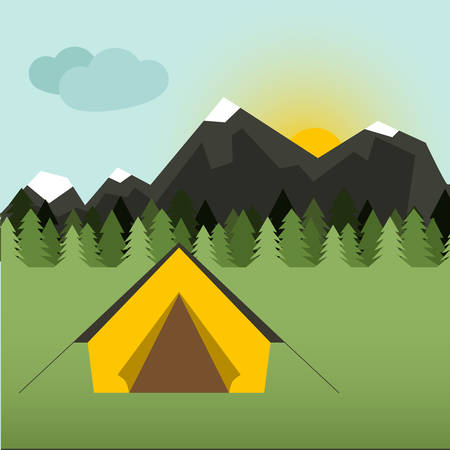1. Understanding the Price Difference
When you’re shopping for camping gear in the U.S., you’ll notice that prices can vary a lot—even for items that look pretty similar at first glance. So, what actually makes one piece of gear cheap and another expensive? Here are the main factors to consider:
Materials
The type and quality of materials used play a huge role in the price of camping equipment. For example, tents made with lightweight, durable ripstop nylon or high-end waterproof coatings will cost more than those made with basic polyester. Sleeping bags stuffed with real down are warmer and pack smaller than synthetic ones, but they also come with a higher price tag.
| Material Type | Cheap Gear | Expensive Gear |
|---|---|---|
| Tent Fabric | Standard polyester | Ripstop nylon, silicone-coated fabrics |
| Sleeping Bag Fill | Synthetic fiber | Goose or duck down |
| Pole Material | Fiberglass | Aluminum or carbon fiber |
Brand Reputation
In the U.S., some outdoor brands like REI, Patagonia, The North Face, and MSR have built strong reputations for quality and customer service. Well-known brands often charge more because their products tend to be more reliable and come with better warranties or customer support. Lesser-known or generic brands usually offer lower prices, but you might be taking a gamble on performance and longevity.
Technological Features
Modern camping gear isn’t just about basic shelter anymore. Higher-priced items often include advanced features like ultralight design, waterproof zippers, built-in LED lighting, or integrated charging ports for your phone. These extras can make your camping experience more comfortable or convenient—but they do add to the cost.
Feature Comparison Example:
| Gear Type | Cheap Version Features | Expensive Version Features |
|---|---|---|
| Tent | Basic rainfly, standard poles, few vents | Full-coverage rainfly, multiple doors/vents, color-coded setup, ultralight poles |
| Cot/Pad | Thin foam pad, no insulation | Self-inflating pad, insulated layers, compact pack size |
| Camping Stove | No wind protection, manual ignition only | Piezo ignition, wind screens, simmer control, fuel efficiency tech |
The Bottom Line on Pricing Factors (No Conclusions!)
The price difference between cheap and expensive camping gear comes down to what goes into making it: the materials used, the brand behind it, and any cool new features it offers. Understanding these factors helps you decide if paying extra is really worth it for your next adventure.
2. Cheap Gear: Pros, Cons, and Ideal Scenarios
The Upside of Affordable Camping Gear
Cheap camping gear has a lot going for it, especially if you’re just getting started or don’t want to spend a fortune right away. Here are some key benefits:
- Budget-Friendly: You can pick up everything you need without emptying your wallet. This is great for families, students, or anyone who wants to try camping without a big commitment.
- Easily Replaceable: If something breaks or gets lost, it’s usually not a huge deal to replace cheap gear.
- Low-Stakes for Beginners: If you’re unsure about how often you’ll use your gear, it makes sense to start with affordable options.
The Downside of Cheap Camping Gear
Of course, there are also some drawbacks when it comes to less expensive equipment:
- Durability Issues: Cheaper gear is often made with lower-quality materials, so it may wear out faster—especially on rough terrain or in bad weather.
- Less Comfort and Features: You might miss out on things like extra padding, lightweight designs, or better waterproofing.
- Limited Use Cases: Budget gear usually isn’t built for extreme conditions or long trips into the backcountry.
When Is Cheap Camping Gear the Right Choice?
If you’re wondering whether budget gear could work for your next camping trip, here are some scenarios where it’s a smart move for American campers:
| Scenario | Why Cheap Gear Makes Sense |
|---|---|
| First-Time Campers | You’re testing the waters and don’t want to invest until you know you enjoy camping. |
| Car Camping at Developed Campgrounds | Amenities like bathrooms and picnic tables mean you don’t need high-end gear to stay comfortable. |
| Kid’s or Teen’s First Trip | No worries if gear gets dirty or damaged while kids learn the ropes outdoors. |
| Group Outings or Large Gatherings | If you need to outfit several people at once (like Scouts or family reunions), affordable gear helps keep costs down. |
| Short Weekend Trips in Good Weather | Mild conditions put less stress on basic gear, so fancy features aren’t as necessary. |
Quick Tip
If you choose cheap gear, always double-check weather ratings and read reviews from other campers in the U.S. This can help you avoid common issues and make sure your experience is still fun and safe!

3. Expensive Gear: Is It Worth the Splurge?
If you’ve ever browsed a camping store, you know there’s a big difference in price between basic and premium gear. But is shelling out extra cash for expensive camping equipment really worth it? Let’s break down what you get when you invest in top-tier gear and when spending more actually makes sense.
The Advantages of High-End Camping Gear
| Feature | Cheap Gear | Expensive Gear |
|---|---|---|
| Durability | May wear out quickly; prone to rips or breaks | Built to last for years; withstands heavy use |
| Weather Protection | Basic protection; may leak or fail in harsh conditions | Superior waterproofing, wind resistance, and insulation |
| Comfort & Design | Simpler design; less comfortable features | Thoughtful details; better materials, comfort, and support |
| Weight & Packability | Tends to be heavier and bulkier | Lighter and easier to carry on long hikes or backpacking trips |
| Warranty & Support | Limited coverage if any | Often includes extended warranties and great customer service |
When Does Premium Camping Gear Make Sense?
You don’t always need to go top-of-the-line for every item. However, investing in high-quality gear pays off in certain situations:
- You camp frequently: If you’re outdoors several times a year, durable gear saves money over time.
- You tackle tough environments: Backpacking in the Rockies or camping during stormy weather? Better gear can keep you safe and dry.
- You value comfort: For longer trips or if you have back problems, premium sleeping pads or chairs can make a huge difference.
- You hike long distances: Ultralight tents and packs are worth it for backpackers who want to save weight.
- You want peace of mind: Reliable gear means less stress about stuff breaking miles from civilization.
Examples of Smart Investments
If you’re looking to prioritize your budget, here are some camping items where spending more can make a real difference:
- Tents (for better weather protection and longevity)
- Sleeping bags (higher warmth ratings and lighter weight)
- Packs (for comfort on long hikes)
- Stoves (reliable performance even in cold or windy conditions)
- Rain gear (staying dry is essential for safety)
4. What to Splurge On vs. Where to Save
Tents: Shelter Matters
Your tent is your home away from home, so it’s smart to spend a bit more here—especially if you’re camping in unpredictable weather. Cheap tents might leak, break poles easily, or offer poor ventilation. Look for trusted brands with good reviews. If you only camp in mild conditions or rarely go out, a budget tent can work, but for frequent campers or trips where weather is a concern, investing in a quality tent pays off.
Tent Comparison Table
| Category | Save | Splurge |
|---|---|---|
| Weather Resistance | Summer/Good Weather Only | All-Season/Durable Materials |
| Weight | Car Camping (Heavier Okay) | Backpacking (Lightweight Essential) |
| Features | Basic Setup, Few Extras | Easy Set-Up, Vestibules, Ventilation |
Sleeping Bags: Comfort and Warmth Count
If you’ll be sleeping outdoors in cooler temps or at higher elevations, a high-quality sleeping bag can make or break your trip. Less expensive bags may save money upfront, but they often weigh more and don’t keep you as warm. For summer camping or sleepovers, a cheap sleeping bag is fine. For backpacking or chilly nights, invest in a down or high-end synthetic bag rated for the lowest temps you expect.
Backpacks: Carrying the Load
If you’re only car camping and carrying gear short distances, a simple, affordable duffel bag does the job. But if you’re hiking miles with your gear on your back, don’t skimp on your backpack. A well-designed pack offers comfort, support, and durability—and can prevent sore shoulders and backs.
Pads & Sleeping Mats: Balance Comfort and Cost
A decent pad makes all the difference for sleep quality. Budget foam mats work for fair-weather campers or kids. For adults or rough sleepers—or if you want to avoid cold ground—a self-inflating or insulated pad is worth the splurge.
Where to Save vs. Where to Spend Table
| Gear Category | When to Save | When to Spend More |
|---|---|---|
| Tent | Fair weather, infrequent use | Frequent trips, bad weather, backpacking |
| Sleeping Bag | Warm climates, casual use | Cold climates, multi-day trips |
| Backpack | Car camping/minimal hiking | Backpacking/long hikes/heavy loads |
| Pads/Mats | Younger campers/short trips/good sleepers | Bony sleepers/cold conditions/longer trips |
| Cooking Gear & Utensils | Bargain kits/basic meals/picnic-style eating | If cooking elaborate meals or need lightweight options for backpacking |
| Lamps & Headlamps | Sporadic use/daylight-heavy trips/close to car | Nocturnal activities/night hiking/remote campsites |
The Takeaway: Invest Where It Counts!
The best approach? Decide what kind of camper you are and match your spending to your style and destination. Put your dollars toward items that protect your safety and comfort—like tents, sleeping bags, and backpacks—and consider saving on accessories and extras where performance isn’t as critical.
5. Tips for Finding Quality Gear on a Budget
Getting outside shouldn’t break the bank, and you don’t have to splurge to find solid camping gear in the U.S. Here are some practical ways to score quality equipment without spending a fortune.
Shop Big Sales and Clearance Events
Major U.S. retailers like REI, Bass Pro Shops, Walmart, and Dick’s Sporting Goods offer big sales throughout the year. The best times to snag deals include:
| Sale Event | Typical Timing | What to Expect |
|---|---|---|
| REI Garage Sale & Anniversary Sale | Spring (May) & Fall (October) | Discounts on returned or overstocked gear, up to 50% off |
| Black Friday & Cyber Monday | Late November | Sitewide and in-store markdowns on tents, sleeping bags, cookware, and more |
| End-of-Season Clearance | Late summer or early winter | Clearance prices as stores make room for new inventory |
Try Outdoor Gear Rental Programs
If you’re just starting out or only camp a few times a year, renting gear can save you serious cash. Many outdoor retailers and local outfitters offer rental programs. Here’s how it works:
- REI Rentals: Rent everything from tents to backpacks at select locations nationwide.
- Local Outfitters: Search for outdoor shops near state or national parks—they often rent basics like stoves, lanterns, and sleeping pads.
- Parks and Campsites: Some U.S. state parks also offer gear lending libraries for campers.
Rental Pros vs. Buying Cheap Gear
| Renting Gear | Buying Cheap Gear | |
|---|---|---|
| Upfront Cost | Low per trip | Low, but adds up if you need frequent replacements |
| Quality Level | Usually high-quality brands | Often lower durability/materials |
| Long-Term Value | No storage or maintenance needed; great for infrequent campers | Might not last long; good for backup or kids’ use |
Score Deals on Second-Hand Gear
The second-hand market is thriving in the U.S., especially for outdoor gear. Look for these sources:
- Facebook Marketplace & Craigslist: Find gently used tents, packs, and coolers from local sellers.
- Ebay & GearTrade: National options for used (and sometimes new) gear shipped right to your door.
- REI Used Gear Program: Shop certified pre-owned items online with peace of mind about condition.
- Yard Sales & Thrift Stores: Sometimes you’ll get lucky with brand-name finds at rock-bottom prices.
Second-Hand Shopping Tips:
- Check zippers, seams, and poles closely before buying.
- Avoid buying used sleeping pads or mattresses unless you can inspect them in person.
- If possible, set up tents or try on packs before finalizing your purchase.
The bottom line: Whether you’re hitting clearance racks, renting what you need, or hunting for used gems, there are plenty of ways American campers can stretch their budget without sacrificing safety or comfort on the trail.


